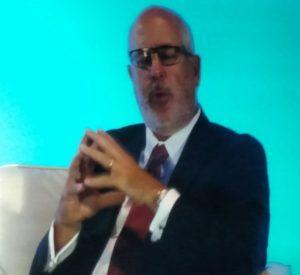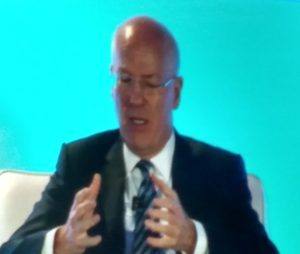Chief executive officers of property/casualty insurance carriers and insurance brokers called each other out last week for engaging in activities they said are “classic signs of a soft market.”
During a session of the S&P Global Ratings Insurance 2017 conference in New York, carrier CEOs attacked brokers for setting up soft market facilities. They also questioned brokers’ compensation.
Brokers shot back, defending their facilities and their compensation and suggesting the CEOs are not dealing with facts or their non-distribution costs.
The soft market “facilities” and competitors who give brokers the authority to create them came in for criticism from carrier executives.
“We don’t need the broker to be underwriting or accepting risk. And I think it’s a major mistake for the industry for us to delegate that authority to a broker. It’s like giving the keys to the inmates,” said Tokio Marine HCC Chief Executive Officer Christopher Williams.
That was hardly the most pointed comment to come during the two-day conference. A day later, brokers shot back that a crescendo of carrier complaints about them—and their levels of compensation—were simply typical byproducts of the carriers’ frustration about the competitive market, and they challenged carriers to manage expenses other than distribution costs.
“I recently was part of a panel in London, and people were talking about frictional cost—and both of the insurance company executives [participating] had flown over on their private planes,” said Steve DeCarlo, CEO of wholesale broker AmWINS, gearing up for a jab at carriers. “When you eliminate your private plane, I’ll reduce a little bit of what I make,” he said, at other times referring to the five cents out of every premium dollar he makes.
“We can have these debates, but I’m comfortable that we’re all in a very competitive environment that doesn’t let either the carrier or the retailer get out ahead of itself in terms of making too much money,” he said, later joining two retail broker CEOs—Greg Case of Aon and Dan Glaser of Marsh & McLennan Companies—to comment on carrier misstatements about “broker facilities” and about how these facilities differ from managing general agents.
DeCarlo alluded to the fact that his firm created a facility a few years back for a reduced commission. “We worked for no extra money, and we actually tried to reduce the frictional cost because we were given an exclusive,” he said, referring to an excess property insurance facility AmWINS put together for investment manager Nephila.
As DeCarlo’s private plane anecdote suggests, the carrier criticisms of brokers started surfacing well in advance of the S&P conference this year, with the likes of Chubb CEO Evan Greenberg, Validus Holdings CEO Ed Noonan and Sompo International CEO John Charman offering negative commentary about excessive commission levels of brokers, particularly in the London market, and about broker practices of packaging related risks together for portfolio placements with predesignated panels of carriers.

Referring specifically to Greenberg, Noonan and Charman, who were not present at the S&P conference, Julie Herman, an S&P director and moderator of the panel of broker CEOs, asked Case to talk about broker remuneration trends last Thursday.
“The calculus is a little bit wrong…This isn’t about brokers or carriers. It’s about client need and client value,” said Case, coming back to an idea that he repeated several times during the session—that there are great opportunities for both brokers and carriers to innovate to address top-of-mind client risks rather than battling against each other.
Going on to address the compensation question directly, Case said, “If you look at our yield as a percent of premium placed, that’s been relatively stable over that period of time. So it’s unclear as to the diagnostic around cost that’s being described. But it’s not coming from Aon,” he said, speculating that it isn’t coming from Marsh either.
“Our focus is about value—delivering value for clients. Our aim is not to be the lowest cost. Our aim is to be the highest value…That’s what we’re going to go for in a highly, highly transparent way.”

Glaser agreed with DeCarlo and Case. “If a broker was earning too much money, the risk is not a carrier, it’s another broker who would take the account. Competition works,” he said.
He continued: “You don’t hear much about broker remuneration when rates are rising. It’s a function of a soft market environment. I understand the frustration, but I view the environment largely where carriers have more angst versus other carriers than they do versus brokers. Oftentimes I get together with insurance company executives and a quarter of the meeting is spent with them complaining about other insurance companies and what they’re doing,” he said, noting that the struggles for carriers to differentiate themselves have become significant.
“I remember when I was in the business 15, 20 years ago, there were three or four insurance companies that did environmental insurance. Now there’d be 60 or 70,” he said, noting similar trends in other product areas that used to be highly specialized, such as Reps and Warranties insurance.
Echoing Case, Glaser said long-term broker compensation trends don’t support recent carrier criticism.

“You have to go look at facts, and if you take all the premium that Marsh has against all the revenue that Marsh has, and you look at it over a number of years, it has been relatively stable over long stretches of time. Even in A.M. Best data, over a 30-year period, the total brokerage level versus premiums has been remarkably consistent.
“I get the frustration, but I think it’s largely misplaced,” he said. “I think it’s a function of the competitive market environment.”
Keep the Pen, Carriers Say
S&P Managing Director Kevin Ahern, moderating a panel of carrier CEOs a day earlier, asked specifically about “broker-led facilities,” drawing almost the same words from Williams of Tokio Marine HCC as Glaser would speak a day later.
“They’re a classic sign of a soft market,” Williams said. “The only way that broker facilities come about is the agreement of reinsurers to delegate authority away. So we create the problems ourselves, and the obvious way to stop that is to stop reinsurers from giving authorization to some of these facilities.”
On both sides—carrier and broker—the executives were careful to point out their need for one another in bringing value to customers.
“The broker is an integral part of what we do. They obviously bring expertise to the table. They bring the client to the table. We absolutely need the broker,” Williams said.
But “we don’t need the broker to be underwriting or accepting risk. And I think it’s a major mistake for the industry—for us—to delegate that authority to a broker.”

Constantine (Dinos) Iordanou, chair and CEO of Arch Capital Group, provided some historical analysis to suggest that brokers running underwriting facilities and underwriting management teams running brokers are recipes for disaster. Iordanou offered insurers associated with Alexander Howden and Frank B. Hall to illustrate the former and St. Paul-Minet the latter.
“What history tells us is that the underwriting mind is different than the mind of the broker. The two don’t mix. If you’re a broker, you think differently. If you’re an underwriter, you think differently. When you try to cross, disasters do happen.”
These days, Iordanou asserted that the broker facilities have “gotten to the point that basically, they’re asking underwriters to give [them] the pen.”
“Brokers don’t know how to underwrite independent of saying that somebody else will and we’re going to follow in their footsteps. And [in] doing that, [the broker] says we’re going to increase the placement cost significantly because we can’t really justify to the client more advisory cost. So, in essence, we’re trying to hide behind efficiencies,” he said, echoing comments made by Greenberg and other carriers not present at the conference.
“At the end of the day, we’re producing a product that is not sustainable in the marketplace, and, in my view, I would never run an underwriting facility that is willing to give its pen to a broker, independent of how much we love them…At the end of the day, without brokers we have no business, right? It’s our distribution channel. But I strongly believe that the good underwriting companies will keep the underwriting pen within their walls and then continue to negotiate what is a proper compensation for the placement of that business and the advisory function the brokers do on behalf of the client.”
He concluded: “In the history [of the business], I have not seen any of these facilities produce profits in the long run. If somebody has one, maybe I missed it. I’m on the Internet; send me an email. Maybe it was an education I didn’t have.”
Brokers Address Facility ‘Buzz’
Responding to an invitation to address carrier concerns a day later, Aon’s Case described one of his firm’s recent innovations that is being described by some as a “facility”: the Aon Client Treaty. According to material on Aon’s website, the Aon Client Treaty, launched in January 2016 and led by XL Catlin, provides “automatic pre-secured coinsurance capacity” of 20 percent on any order placed in the London market through Aon’s Global Broking Centre. The multiyear coverage is full follow-form on terms, conditions and pricing of the lead market, supported by a panel of Lloyd’s syndicates.
“Why aren’t we talking about the fact that the global insurance marketplace, if you ask a question of relevance—Are we more or less relevant collectively than we were five years ago or 10 years ago?—I think you can make an argument toward we are even or less,” Case said. “As the world is changing, are we evolving as fast?”
“This is about clients, clients, clients,” continued Case, who admitted that he had missed the objections raised by Iordanou and Williams about underwriters directly handing brokers their underwriting pens. Instead, he addressed pre-conference comments from other carrier executives quoted in the trade press, who believe that carriers signing on to slices of high-volume portfolios are accepting unsustainable terms and prices, and who question increased compensation associated with facilities.
“It all has to go back to the fact of client need and start with that,” Case said, reporting the following account of conversations between clients placing business in London and Aon representatives:
“When we do so, we create a tower [and] the syndicates at the tail end of that tower sometimes change our deal. Could you guys please do something about that?” the clients say.
“Answer, not sure we can. It’s been that way for 325 years,” Case said initially.
“However, we’ve actually been tracking data analytics up against this market for quite some time,” and Aon was able to look at $5 billion in premiums for 6,000 clients that it placed into London, Case reported. “We looked at those clients over the last three years—at every single granular part of placement—literally 160 countries, probably almost 100,000 individual different types of placements. We looked at that over three years from a profitability standpoint, and we were able to come back with a way to think about the back-end placement, the last 20 percent.
“So, we actually eliminated the tail risk of placement to London,” he said, noting that clients are not required to sign onto this. “It was an opt-in. If they want it, they can use it. If they don’t, they don’t.
“That, to us, is a pretty big tour de force investment in content. That’s not about a facility. It’s about content,” he said, going on to suggest that comparing this innovation to a “facility” is like comparing a Tesla to a Model T. “They both roll down the road. They both do their thing. But under the hood they’re very, very different,” he said. “This sparks an evolution.
“This is about clients,” he repeated. “The problem we are trying to solve is really important. That problem would have to be a client problem.”
Reports about the London market (“London Market Review: Property, Casualty & Political Violence“) available on Aon’s website for 2016 and 2017, stress that both underwriters and clients benefit from the Aon Client Treaty (ACT), noting that reducing individual account-by-account underwriting to a single treaty creates efficiencies in London. “For London underwriters, the business case for participating on ACT is the one-stop access to the broadest portfolio of risks available anywhere in the world, via a vehicle that has the potential to provide a significant expense cost benefit. For the London market, ACT is of added significance because it offers a new solution to clients, as a result of the market’s ability to manage big data linked to advanced analytics. We expect to see further developments in this space as London brokers and underwriters focus on where big data can provide a competitive edge,” the 2016 report says.
“Drawing on information from 64,000 policy transactions, 120 different classes of business and 157 countries, Aon built a data room that enabled Lloyd’s underwriters, led by XL Catlin, to carry out comprehensive due diligence on the risk portfolio and bring underwriting rigor to the creation of ACT,” the report said.
As for clients, an ACT description on Aon’s website likens the frustrations they face in trying to cobble together excess layers of capacity to a game of Tetris. The layers—like varying shapes of Tetris blocks—differ in terms of “attachment points, limits, wordings, subjectivities, [and] they also have different prices, driven by basic supply and demand, with the overlay of individual underwriting judgment,” the document says. “From the client’s perspective, we need to create bigger and more uniform blocks of capacity and reduce or eliminate any ambiguity in the pricing mechanism,” it says, also suggesting that any misalignment of one of the insurance contracts in a Tetris-type placement might complicate claims recoveries related to massive liability claims or natural disasters.
‘Facilities’ vs. MGAs
During the broker CEO panel at the conference, MMC’s Glaser said that reports he read about remarks by Williams and Iordanou about “facilities” suggested that the carriers were misinformed. “There’s some level of talking about an MGA and a facility like they’re the same thing. I’m not aware…of broker facilities where the pen has been given to the broker and the broker is underwriting the risk and perhaps even taking things on their balance sheet.
“Let me make myself perfectly clear as it relates to Marsh & McLennan. In our facilities, we don’t want an underwriter’s pen, we don’t want to underwrite on their behalf, and we do not want to put risk on our balance sheet,” he said.
“An MGA is different. An MGA might be that you have a specialized niche capability where you actually think you can underwrite the risk on behalf of the carrier. We do have some MGA businesses. They are far different than facility businesses,” he said, giving the example of Victor O. Schinnerer, a Marsh MGA that has had a relationship on architects and engineers insurance with CNA for 60 years. “We do underwriting on their behalf. That’s very different from facilities.”
Glaser described four operating principles for facilities:
- “One, there has to be a tangible and demonstrable client value. The client has to benefit.
- “Two, that has to be the cause of creating the facility in the first place—to benefit the client.
- “Then, there’s got to be some level of sound process in selecting the carriers because typically on a facility, you may get 50 carriers who want to participate, and there may only be five or 10 spots. There has to be a process that’s fair and open and transparent in terms of carrier selection.
- “The fourth thing is there has to be a lot of transparency and disclosure with clients. The clients have the capability of either participating or not participating based upon their own desires.”
Like Case, Glaser attributed the ability to make portfolio placements to increased data analytics and predictive insights. “My sense is that in every market environment, some level of facilities will still remain and be effective. The idea that it is brokers underwriting and actually possibly taking risk I think is misunderstood and incorrect,” Case said.
For his part, DeCarlo noted that his firm has been in the MGA business for years. “I started my career in the MGA business, people trusted our underwriting skills, and we made a fee doing them,” he said. “If that’s what people call a facility, there are many of them, it’s been around for a long time, and the carriers trust these individuals to underwrite.”
Like Marsh and Aon, he said AmWINS tries to build capacity through analytics and data for its clients—small retail brokers. “We take no balance sheet exposure, so we’re never a competition with our insurance companies. But there is a level of trust that we can provide the analytics necessary for themto price the product correctly, and we work as a team on that.
“Facility is the new buzzword, and it could be defined many, many ways. We have one program where the premium on the dec page is $140 million, and we’ve been doing that one account for years and years and years. We cover an amazing amount of insureds, and we’ve done an amazing amount of capital building on that.
“Is that a facility? Is that a broker driving price for commission benefit? Or is that a way to solve clients’ problems?
“The client bought it. They’ve been buying it for years; it solves their problems. It allows them to have one claim organization instead of many. It allows them to get one set of wordings instead of many.” Agreeing with Case, DeCarlo concluded, “The client is demanding these things. People can criticize us for these, but they’ve been in the market forever.”
“Soft markets drive interesting questions,” he said.
Sidebar: What Carriers Say?
Chubb Chair and CEO Evan Greenberg has been one of the more vocal critics of what he terms “the ‘facilitization’ of business” taking place “predominantly but not exclusively in the wholesale markets.” During a first-quarter earnings conference call, Greenberg elaborated on views that he included in hiscompany’s annual report. “I think some of that behavior has gone beyond what is reasonable,” he said, arguing that brokers use “high-volume portfolio schemes to attract underwriters…who for the sake of volume will do things to pricing and terms and conditions that aren’t that prudent, that aren’t sustainable, and that they otherwise wouldn’t do when it’s one-off- risk placed.”
Noting the efficiencies created for brokers and underwriters (in some cases), Greenberg added: “Price goes down; compensation goes up. What’s the logic of that? And frankly, in this world today, a digital world where there is greater efficiency and greater transparency, what industry or business do we know about where prices are going down but intermediary percentage of the dollar—of what’s being placed—goes up?” he asked, suggesting change is on the horizon.
Sclafane is Senior Editor of Carrier Management, where this article was originally published.
Topics Carriers Agencies Pricing Trends Underwriting Market Insurance Wholesale London Aon
Was this article valuable?
Here are more articles you may enjoy.



 Progressive Records Five-Fold Increase in Q1 Net Income
Progressive Records Five-Fold Increase in Q1 Net Income  If US Inflation Reflected Rising Home Insurance Costs, It’d Be Even Higher
If US Inflation Reflected Rising Home Insurance Costs, It’d Be Even Higher  JPMorgan Client Who Lost $50 Million Fortune Faces Court Setback
JPMorgan Client Who Lost $50 Million Fortune Faces Court Setback  Viewpoint: Florida Insurance Market on the Mend
Viewpoint: Florida Insurance Market on the Mend 


